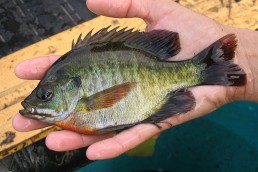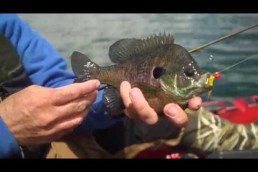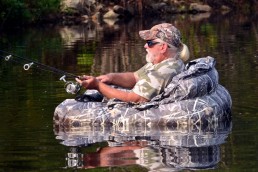SHARE THIS POST
It’s June, and once again it’s the prime time to get out and catch a nice mess of tasty panfish. And without a doubt, the bluegill is one of the scrappiest fish you’ll ever find for its size. As we move into the warm-weather months and water temperatures rise, farm-pond bluegills will make their annual migration into shallow waters to spawn. They will also become aggressive. And when this happens they’re easier to catch.
It’s important to remember that the prime spawning activity for bluegills will peak when water temperatures reach 70 to 75 degrees, and is the prime time to catch them. Also, remember that most farm ponds will warm faster than other waters.
For most of the Midwest, June is the best time to start your search. And if you’re planning on fishing the many farm ponds we are blessed to have here, then you’re going to have to keep in mind that bluegill fishing in these waters is a bit different from when you’re on lakes or rivers. When fishing ponds, current isn’t an issue. Also, the male bluegills will be the first ones in the shallows here and will take on the task of building the spawning nest. You can find these around stumps, green vegetation and sandy-bottomed reed areas. Remember, bluegills prefer a bottom made up of either sand or gravel. But if these areas are not available for them, they’ll fan out their nests in areas that contain a combination of silt and mud on the bottom.
When looking for likely fish-holding spots, nothing beats a good pair of polarized sunglasses. These will block out any glare from the water’s surface and allow you to actually see into the shallower water below. You’ll then be able to spot the bluegill spawning beds. Just remember, when looking for these, do not get too close to that area or you will spook the fish. When you locate them, keep in mind these cover a large area and contain numerous individual beds. In farm ponds, bigger beds are common, and because of the rich ecosystem available in these waters, the bigger fish can thrive. Of course, this is also dependent on the actual size and depth of the pond itself.
Are you enjoying this post?
You can be among the first to get the latest info on where to go, what to use and how to use it!
For fishing them, the best part is you do not need any fancy tackle or a big boat to go out and catch yourself a tasty mess, and bank angling is the norm. Also, because of a bluegill’s aggressiveness during this time, the whole family can have a ball catching some nice fish. And some quality 2- or 4-pound-test line, a few small hooks, split shot and a tiny float is all that is needed. Sticking to the smaller-test line will increase your enjoyment but is strong enough to land the scrappy bluegills you may hook. For a rod, use something very light for best results. And for the youngsters, use a lightweight bamboo pole or old fly rod.
For baits, this is the time to go with small euro larvae-type baits like spikes, waxworms or the old-time favorite, red worms. Over the years, these three have caught more bluegills than I can count. You can also opt for a small ice-fishing jig. That’s right—ice-fishing jig. These tiny, flashy lures are year-round fish catchers and will work well for the bluegills. Simply attach euro larvae bait to the hook, set your small float for the depth you want, and you’re ready to catch some fish. Toss your offering past the beds and slowly work it back through the area. As you do this, you will know very quickly if the bluegills are there. Their aggressive nature will make them attack your offering with reckless abandon. But if the ‘gills are not actually on the beds, simply adjust your lure to go a bit deeper and search the area again. You will find that once you locate or relocate these spawning beds, the bluegills will be in the area nearby for sure. And when you find one bluegill, there are likely many more in the area just waiting to attack your offering.
So, if you know of a farm pond in your area that contains bluegills, now is the time to get out on the water and enjoy some of the best fishing available. Once you get hooked on bluegill fishing on farm ponds, it’ll be for life.
MWO
SHARE THIS POST
Did you enjoy this post?
You can be among the first to get the latest info on where to go, what to use and how to use it!
Mike Cyze
Mike Cyze has been called one of the most knowledgeable multispecies river anglers in the country. His ability to catch fish under the challenging conditions encountered in the river environment, combined with his overall fishing knowledge, has earned him recognition as a true Mississippi River Expert. Contact him at: lastcast13@yahoo.com.



